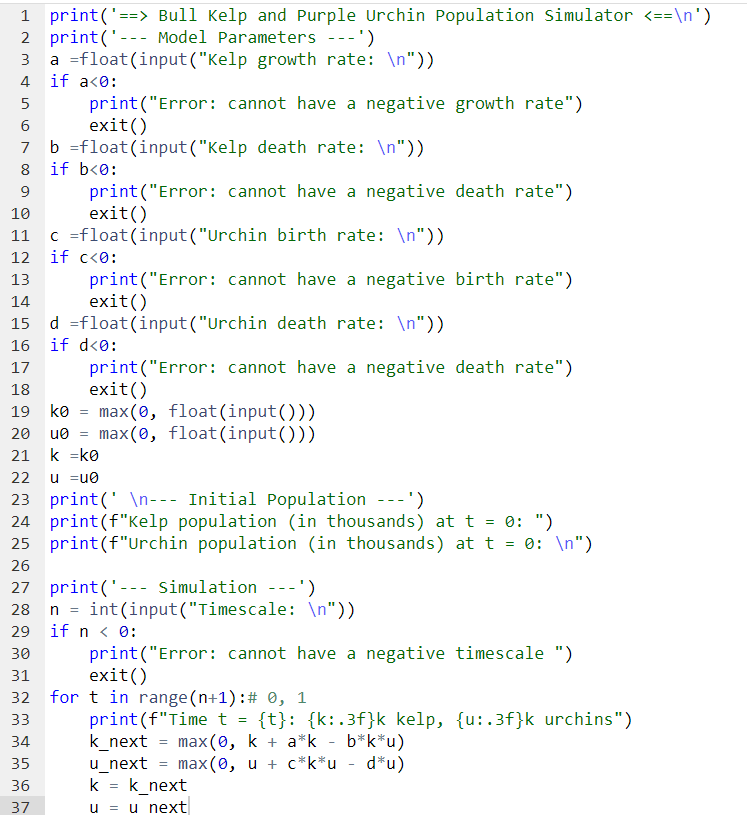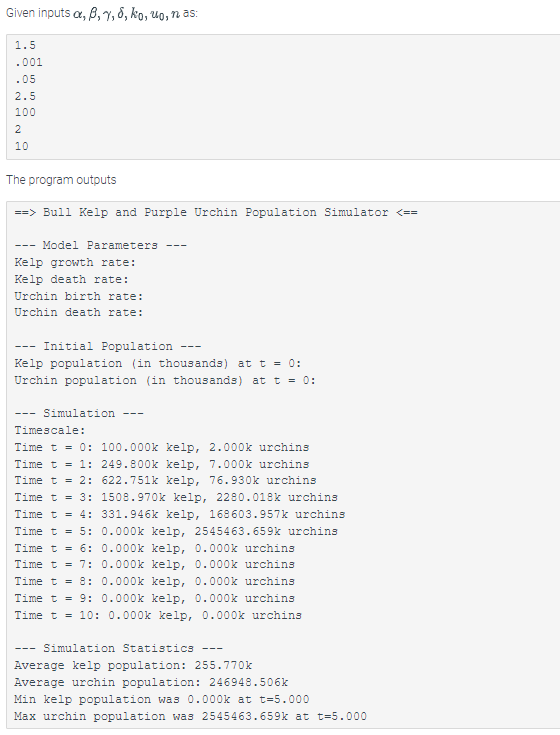Given inputs a, 8, 7, 8, ko, uo, nas: 1.5 .001 .05 2.5 100 2 10 The program outputs ==>Bull Kelp and Purple Urchin Population Simulator <== Model Parameters Kelp growth rate: Kelp death rate: Urchin birth rate: Urchin death rate: Initial Population --- Kelp population (in thousands) at t = 0: Urchin population (in thousands) at t = 0: --- Simulation --- Timescale: Time t = 0: 100.000k kelp, 2.000k urchins Time t = 1: 249.800k kelp, 7.000k urchins Time t = 2: 622.751k kelp, 76.930k urchins Time t = 3: 1508.970k kelp, 2280.018k urchins Time t = 4: 331.946k kelp, 168603.957k urchins 0.000k kelp, 2545463.659k urchins 0.000k kelp, 0.000k urchins Time t = 5: Time t = 6: Time t = 7: 0.000k kelp, 0.000k urchins Time t = 8: 0.000k kelp, 0.000k urchins Time t = 9: 0.000k kelp, 0.000k urchins Time t = 10: 0.000k kelp, 0.000k urchins --- Simulation Statistics --- Average kelp population: 255.770k Average urchin population: 246948.506k Min kelp population was 0.000k at t-5.000 Max urchin population was 2545463.659k at t-5.000
Given inputs a, 8, 7, 8, ko, uo, nas: 1.5 .001 .05 2.5 100 2 10 The program outputs ==>Bull Kelp and Purple Urchin Population Simulator <== Model Parameters Kelp growth rate: Kelp death rate: Urchin birth rate: Urchin death rate: Initial Population --- Kelp population (in thousands) at t = 0: Urchin population (in thousands) at t = 0: --- Simulation --- Timescale: Time t = 0: 100.000k kelp, 2.000k urchins Time t = 1: 249.800k kelp, 7.000k urchins Time t = 2: 622.751k kelp, 76.930k urchins Time t = 3: 1508.970k kelp, 2280.018k urchins Time t = 4: 331.946k kelp, 168603.957k urchins 0.000k kelp, 2545463.659k urchins 0.000k kelp, 0.000k urchins Time t = 5: Time t = 6: Time t = 7: 0.000k kelp, 0.000k urchins Time t = 8: 0.000k kelp, 0.000k urchins Time t = 9: 0.000k kelp, 0.000k urchins Time t = 10: 0.000k kelp, 0.000k urchins --- Simulation Statistics --- Average kelp population: 255.770k Average urchin population: 246948.506k Min kelp population was 0.000k at t-5.000 Max urchin population was 2545463.659k at t-5.000
Computer Networking: A Top-Down Approach (7th Edition)
7th Edition
ISBN:9780133594140
Author:James Kurose, Keith Ross
Publisher:James Kurose, Keith Ross
Chapter1: Computer Networks And The Internet
Section: Chapter Questions
Problem R1RQ: What is the difference between a host and an end system? List several different types of end...
Related questions
Question
100%
with the python code that i have given can you add the part that goes with the Simulation Statistics

Transcribed Image Text:1 print('==> Bull Kelp and Purple Urchin Population Simulator <==\n')
2 print('- Model Parameters ---')
a float(input ("Kelp growth rate: \n"))
if a<0:
print("Error: cannot have a negative growth rate")
exit()
b =float(input("Kelp death rate: \n"))
8 if b<0:
9
10
11 c =float
12 if c<0:
13
14
4
5
6
16
17
18
19 ko
29
30
31
print("Error: cannot have a negative death rate")
exit()
ko = max(0, float(input()))
20 u0= max(0, float(input()))
21
k =k0
33
34
35
22
u =u0
23 print( \n--- Initial Population ---')
24 print (f"Kelp population (in thousands) at t = 0: ")
25 print (f"Urchin population (in thousands) at t = 0: \n")
26
27 print('--- Simulation ---')
m m m
print("Error:
exit()
36
(input("Urchin birth rate: \n"))
print("Error: cannot have a negative birth rate")
exit()
d =float (input ("Urchin death rate: \n"))
if d<0:
37
cannot have a negative death rate")
n = int(input("Timescale: \n"))
if n < 0:
print("Error: cannot have a negative timescale ")
exit()
for t in range (n+1): # 0, 1
print (f"Time t = {t}: {k:.3f}k kelp, {u:.3f}k urchins")
k_next = max(0, k + a*k - b*k*u)
u_next
max (0, u + c*k*u - d*u)
k = k_next
u = u next

Transcribed Image Text:Given inputs a, 6, 7, 8, ko, uo, nas:
1.5
.001
.05
2.5
100
2
10
The program outputs
==> Bull Kelp and Purple Urchin Population Simulator <==
- Model Parameters
Kelp growth rate:
Kelp death rate:
Urchin birth rate:
Urchin death rate:
Initial Population
Kelp population (in thousands) at t = 0:
Urchin population (in thousands) at t = 0:
- Simulation ---
Timescale:
Time t = 0: 100.000k kelp, 2.000k urchins
Time t = 1: 249.800k kelp, 7.000k urchins
Time t = 2:
Time t = 3:
Time t = 4:
Time t = 5:
---
622.751k kelp, 76.930k urchins
1508.970k kelp, 2280.018k urchins
331.946k kelp, 168603.957k urchins
0.000k kelp, 2545463.659k urchins
0.000k kelp, 0.000k urchins
Time t = 6:
Time t = 7:
0.000k kelp, 0.000k urchins
Time t = 8:
0.000k kelp, 0.000k urchins
Time t = 9: 0.000k kelp, 0.000k urchins
Time t = 10: 0.000k kelp, 0.000k urchins
---
Simulation Statistics
Average kelp population: 255.770k
Average urchin population: 246948.506k
---
Min kelp population was 0.000k at t=5.000
Max urchin population was 2545463.659k at t-5.000
Expert Solution
Step 1
Your Python program is given below as you required with an output.
Explanation :
The program first asks the user for the model parameters: kelp growth rate, kelp death rate, urchin birth rate, and urchin death rate. It then asks for the initial kelp and urchin populations.
The simulation then begins, and the program simulates the population dynamics
Trending now
This is a popular solution!
Step by step
Solved in 4 steps with 3 images

Recommended textbooks for you

Computer Networking: A Top-Down Approach (7th Edi…
Computer Engineering
ISBN:
9780133594140
Author:
James Kurose, Keith Ross
Publisher:
PEARSON

Computer Organization and Design MIPS Edition, Fi…
Computer Engineering
ISBN:
9780124077263
Author:
David A. Patterson, John L. Hennessy
Publisher:
Elsevier Science

Network+ Guide to Networks (MindTap Course List)
Computer Engineering
ISBN:
9781337569330
Author:
Jill West, Tamara Dean, Jean Andrews
Publisher:
Cengage Learning

Computer Networking: A Top-Down Approach (7th Edi…
Computer Engineering
ISBN:
9780133594140
Author:
James Kurose, Keith Ross
Publisher:
PEARSON

Computer Organization and Design MIPS Edition, Fi…
Computer Engineering
ISBN:
9780124077263
Author:
David A. Patterson, John L. Hennessy
Publisher:
Elsevier Science

Network+ Guide to Networks (MindTap Course List)
Computer Engineering
ISBN:
9781337569330
Author:
Jill West, Tamara Dean, Jean Andrews
Publisher:
Cengage Learning

Concepts of Database Management
Computer Engineering
ISBN:
9781337093422
Author:
Joy L. Starks, Philip J. Pratt, Mary Z. Last
Publisher:
Cengage Learning

Prelude to Programming
Computer Engineering
ISBN:
9780133750423
Author:
VENIT, Stewart
Publisher:
Pearson Education

Sc Business Data Communications and Networking, T…
Computer Engineering
ISBN:
9781119368830
Author:
FITZGERALD
Publisher:
WILEY